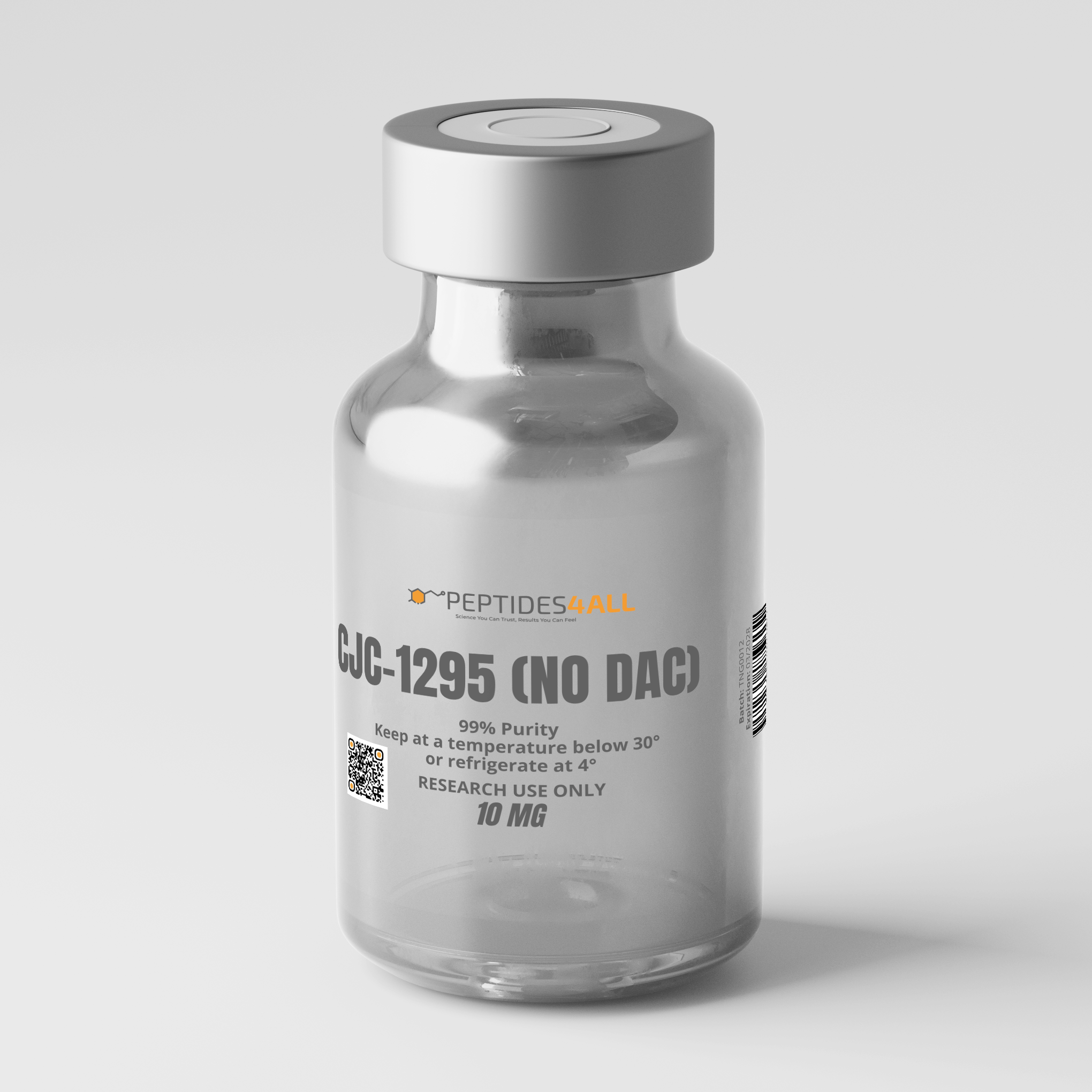PEPTIDES4ALL CJC-1295 No DAC (MOD-GRF 1-29) – Short-Acting GHRH Analogue for Pulsatile GH Research
PEPTIDES4ALL CJC-1295 No DAC, also known as MOD-GRF 1-29, is a synthetic, short-acting analogue of human growth hormone–releasing hormone (GHRH 1-29) designed to replicate the body’s natural, pulsatile secretion of growth hormone (GH).
This optimized 29-amino-acid fragment incorporates four strategic substitutions (His¹→Asp, Ala²→Gly, Asp⁸→Gln, Met¹⁵→Norleucine) that markedly improve enzymatic stability and receptor affinity compared to native GHRH (1-29) (PubMed 10634306).
Unlike the long-acting version CJC-1295 with DAC (Drug Affinity Complex), which forms covalent bonds with plasma albumin and prolongs systemic exposure for several days, the No DAC variant maintains a short plasma half-life of approximately 30 minutes.
This shorter duration allows researchers to precisely model physiologic GH release cycles, enabling controlled studies of endocrine pulsatility, circadian rhythm, and pituitary responsiveness under near-natural conditions.
At the molecular level, CJC-1295 No DAC functions as a pure GHRH receptor (GHRHR) agonist, stimulating the somatotroph cells of the anterior pituitary to release GH in a manner that mirrors the body’s own ultradian GH pulse pattern.
This characteristic makes it an invaluable research tool for investigating growth-hormone feedback loops, IGF-1 kinetics, and metabolic signaling pathways linked to muscle growth, lipolysis, tissue repair, and aging biology (PMC1450515).
One of the most studied applications of MOD-GRF 1-29 is its synergistic interaction with GH secretagogues (GHRPs) such as Ipamorelin, GHRP-2, and GHRP-6.
When administered together, these compounds produce a potentiated GH pulse that exceeds the response from either alone, providing a robust model for dual-pathway pituitary stimulation through both GHRH-dependent and ghrelin-mediated signaling (PubMed 10634306).
Because of its rapid clearance and controllable pharmacokinetics, CJC-1295 No DAC enables fine-tuned experimental design, where timing, dosing, and frequency can be customized to explore acute GH release, receptor desensitization, or IGF-1 expression without the confounding effects of continuous stimulation seen in long-acting analogues.
This makes it particularly valuable in studies on metabolic regulation, sleep-associated GH dynamics, muscle regeneration, and endocrine homeostasis.
With its high purity, reproducible bioactivity, and physiologic relevance, PEPTIDES4ALL CJC-1295 No DAC provides researchers a precise and versatile tool to investigate growth-hormone pulsatility, feedback control, and tissue-specific GH responses within tightly controlled laboratory conditions—bridging classic endocrine physiology with modern peptide-based experimental therapeutics.
Scientific Evidence & Research Findings
-
Natural GH Pulses — In preclinical and human studies, short-acting GHRH analogues like MOD-GRF 1-29 stimulate GH release that mirrors the body’s own pulsatile secretion pattern. This supports research into circadian GH dynamics, sleep-associated GH secretion, and metabolic regulation. https://pubmed.ncbi.nlm.nih.gov/10634306/
-
Synergy with GHRPs — When combined with GH secretagogues (e.g., GHRP-2, GHRP-6, or Ipamorelin), MOD-GRF 1-29 produces amplified GH pulses compared to either compound alone, offering an additive model of pituitary stimulation. https://pubmed.ncbi.nlm.nih.gov/10634306/
-
Short Half-Life Advantage — The ~30-minute plasma half-life allows precise control over timing and frequency of GH release, an advantage in protocols that aim to replicate natural GH rhythms or assess acute GH/IGF-1 dynamics.
-
Research Applications — Investigated in models of muscle growth, fat metabolism, tissue repair, and anti-aging biology, with emphasis on its controlled, non-sustained profile versus long-acting analogues.
Key Research Benefits & Applications
-
Mimics physiological GH pulses rather than continuous elevation
-
Enhances GH release with synergistic GHRP combinations
-
Useful for studying GH’s role in muscle, fat, and metabolic regulation
-
Short, controllable half-life for precise experimental design
-
High purity, stable lyophilized powder for reproducibility
Presentation & Handling
- Form: Supplied as lyophilized peptide in sterile vial.
- Reconstitution: Use bacteriostatic water or 2% procaine; swirl gently (do not shake vigorously).
- Storage: Store at –20 °C, protected from light and moisture. After reconstitution, use according to research protocols and handle under sterile conditions.
Intended Use
For research purposes only. Must be handled in accordance with institutional protocols and ethical guidelines.
